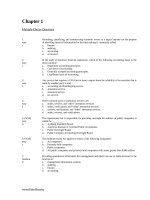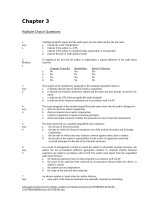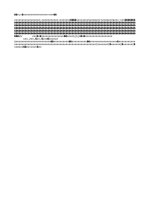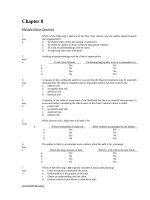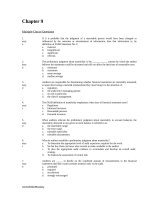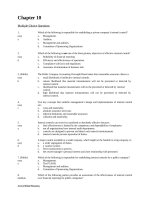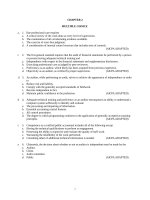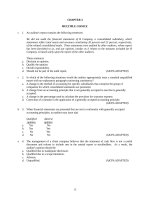Test bank auditing and assurance principles by arens, elder beasley chapter 16
Bạn đang xem bản rút gọn của tài liệu. Xem và tải ngay bản đầy đủ của tài liệu tại đây (71.29 KB, 15 trang )
Chapter 16
Multiple-Choice Questions
1.
easy
a
Which of the following is not a balance-related audit objective evaluated in the audit of
accounts receivable?
a. Timing
b. Realizable value
c. Completeness
d. Accuracy
2.
easy
b
The two primary classes of transactions in the sales and collection cycle are:
a. sales and sales discounts.
b. sales and cash receipts.
c. sales and sales returns.
d. sales and accounts receivable.
3.
easy
c
The appropriate evidence to be obtained from tests of details must be decided on a(n):
a. efficiency basis.
b. effectiveness basis.
c. audit objectives basis.
d. none of the above.
4.
easy
a
Which of the following is not a balance-related audit objective evaluated in the audit of
accounts receivable?
a. Occurrence
b. Completeness
c. Rights
d. Accuracy
5.
easy
d
Tests of which balance-related audit objective are normally performed first in an audit of the
sales and collection?
a. Accuracy
b. Completeness
c. Rights
d. Detail tie-in
6.
easy
d
For most audits, inherent risk for accounts receivable is moderate or low except for which
balance-related audit objectives?
a. Timing and realizable value.
b. Completeness and existence.
c. Existence and accuracy.
d. Realizable value and cutoff.
7.
easy
d
Which of the following types of receivables would not deserve the special attention of the
auditor?
a. Accounts receivables with credit balances.
b. Accounts that have been outstanding for a long time.
c. Receivables from affiliated companies.
d. Each of the above would receive special attention.
Arens/Elder/Beasley
8.
easy
b
A listing of the balances in the accounts receivable master file at the balance sheet date, by total
balance outstanding and by the amount of time the component parts have been outstanding, is
the:
a. customer list.
b. aged trial balance.
c. accounts receivable ledger.
d. schedule of accounts receivable.
9.
easy
a
Testing the information on the aged trial balance for detail tie-in is a necessary audit procedure,
which would normally include:
Test-footing the total column and
the columns depicting the aging
a.
b.
c.
d.
Yes
No
Yes
No
Comparing the total of the aged trial balance with
the general ledger accounts receivable account
Yes
No
No
Yes
10.
easy
c
Auditors are often concerned with three aspects of internal controls related to the sales and
collection cycle. Which of the following is not one of those controls?
a. Controls that detect or prevent embezzlements.
b. Controls over cutoff.
c. Controls over acquisitions.
d. Controls related to the allowance for doubtful accounts.
11.
easy
c
Cutoff misstatements occur when:
a.
b.
c.
d.
The auditor fails to obtain the endof-year bank statement directly from
the bank, obtaining instead the
statement which includes the two
succeeding weeks
Yes
Yes
No
No
Subsequent period
transactions are
recorded in the
current period
Yes
No
Yes
Yes
Current period
transactions are
recorded in the
subsequent period
No
Yes
Yes
No
12.
easy
a
Cutoff misstatements occur:
a. either by error or fraud.
b. by error only.
c. by fraud only.
d. randomly without causes related to errors or fraud.
13.
easy
c
Generally accepted accounting principles require that material sales returns and allowances be:
a. recorded in the period when the merchandise is returned.
b. recorded in the period when the credit memo is issued.
c. matched with related sales.
d. recorded as a debit to the sales account.
14.
easy
d
Communication addressed to the debtor requesting him or her to confirm whether the balance as
stated on the communication is correct or incorrect is a:
a. representation letter.
b. negative confirmation.
c. bank confirmation.
d. positive confirmation.
Arens/Elder/Beasley
15.
easy
a
A type of positive confirmation known as a blank confirmation:
a. requests the recipient to fill in the amount of the balance.
b. is considered less reliable than the regular positive confirmation.
c. generates as high a response rate as the regular positive confirmation form.
d. is used when the auditor is confirming several small balances.
16.
medium
a
For sales, the occurrence transaction-related audit objective affects the ______ balance-related
audit objective.
a. existence
b. completeness
c. rights
d. detail tie-in
17.
medium
b
For cash receipts, the occurrence transaction-related audit objective affects the ______ balancerelated audit objective.
a. existence
b. completeness
c. rights
d. detail tie-in
18.
medium
b
Which of the following is likely to be determined first when performing tests of details for
accounts receivable?
a. Recorded accounts receivable exist.
b. Accounts receivable in the aged trial balance agree with related master file amounts, and
the total is correctly added and agrees with the general ledger.
c. Accounts receivable are owned.
d. Existing accounts receivable are included.
19.
medium
a
Analytical procedures are substantive tests and, if the results of the analytical procedures are
favorable, the auditor will:
a. reduce the extent of tests of details of balances.
b. reduce the extent of tests of controls.
c. reduce the tests of transactions.
d. reduce all of the other tests.
20.
medium
c
The most effective test of details of accounts receivable is the:
a. detail tie-in of the records.
b. analysis of the allowance for doubtful accounts.
c. confirmation of accounts receivable.
d. examination of sales invoices.
21.
medium
a
Tests of details of balances are directed to:
a. balance sheet accounts for all cycles.
b. income statement accounts for all cycles.
c. balance sheet accounts for some cycles and income statement accounts for other cycles.
d. all general ledger accounts for all cycles.
22.
medium
a
The most important test of details of balances for accounts receivable is:
a. confirmations.
b. recalculation of the aged receivables and uncollectible accounts.
c. tracing credit memos for returned merchandise to receiving room reports.
d. tracing from shipping documents to journals to the accounts receivable ledger.
The most important test of details of balances to determine the existence of recorded accounts
23.
Arens/Elder/Beasley
medium
d
receivable is:
a. tracing details of sales invoices to shipping documents.
b. tracing the credits in accounts receivable to bank deposits.
c. tracing sales returns entries to credit memos issued and receiving room reports.
d. the confirmation of customers’ balances.
24.
medium
b
When should auditors not perform alternative procedures in testing the accounts receivable
balance?
a. When customers do not return positive confirmation requests.
b. When customers do not return negative confirmation requests.
c. When confirmations are deemed to be ineffective as an audit procedure.
d. When confirmations are too costly to use.
Because of its central role in auditing of accounts receivable, the ______________ is one of the
first items tested.
a. accounts receivable master file
b. customer file
c. aged trial balance
d. sales register
25.
medium
c
26.
medium
c
If accounts receivable accounts with credit balances are significant, they should be:
a. written off.
b. moved to the debit side.
c. reclassified as accounts payable.
d. corrected by making adjusting entries.
27.
medium
b
Most tests of accounts receivable are based on what schedule, file, or listing?
a. Sales master file.
b. Aged accounts receivable trial balance.
c. Accounts receivable master file.
d. Accounts receivable general ledger account.
28.
medium
a
If the client’s internal control for recording sales returns and allowances is evaluated as
ineffective:
a. a larger sample is needed to verify cutoff.
b. sampling is not appropriate.
c. all sales returns must be traced to supporting documentation.
d. all sales returns must be confirmed with the customer.
29.
medium
d
A customer mails and records a check to a client for payment of an unpaid account on
December 30. The client receives and records the amount on January 2. The records of the two
organizations will be different on December 31. This represents
a.
b.
c.
d.
A cutoff misstatement
Yes
No
Yes
No
A timing difference
Yes
No
No
Yes
30.
medium
c
Which of the following audit procedures would not likely detect a client’s decision to pledge or
factor accounts receivable?
a. A review of the minutes of the board of directors’ meetings.
b. Discussions with the client.
c. Confirmation of receivables.
d. Examination of correspondence files.
31.
When do most companies record sales returns and allowances?
Arens/Elder/Beasley
medium
b
a.
b.
c.
d.
32.
Medium
a
Cutoff misstatements can occur for:
a.
b.
c.
d.
During the month in which the sale occurs.
During the accounting period in which the return occurs.
Whenever the customer contacts the company regarding the credit.
During the month after the sale occurs.
Sales
Yes
No
Yes
No
Sales returns and allowances
Yes
No
No
Yes
33.
medium
b
The most important aspect of evaluating the client’s method of obtaining a reliable cutoff is to:
a. perform extensive detailed testing of cutoff.
b. evaluate the client’s control procedures around cutoff.
c. confirm a sample of transactions near period end with customers.
d. confirm transaction with customers.
34.
medium
d
A positive confirmation is more reliable evidence than a negative confirmation because:
a. fewer confirmations can be sent out.
b. the auditor has a document which can be used in court.
c. the debtor’s lack of response indicates agreement with the stated balance.
d. follow-up procedures are performed if a response is not received from the debtor.
35.
medium
a
The advantage of using the negative form of confirmations is that:
a. larger sample sizes can be used without increasing the costs above what would have been
required for positive confirmations.
b. a non-response from the customer proves that the balance is correct.
c. follow-up procedures are scheduled automatically.
d. they provide greater reliance.
36.
medium
b
Which of the following procedures do most auditors perform when auditing the allowance for
doubtful accounts?
a. Send positive confirmations.
b. Inquire of the client’s credit manager.
c. Send negative confirmations.
d. Examine sales invoices.
When positive confirmations are used, auditing standards require follow-up procedures for
confirmations not returned by the customer. In such a situation, which of the following would
not be classified as an alternative procedure?
a. Send a second confirmation request.
b. Examine subsequent cash receipts to determine if the receivable has been paid.
c. Examine shipping documents to verify that the merchandise was shipped.
d. Examine customer’s purchase order and the duplicate sales invoice to determine that the
merchandise was ordered.
37.
medium
a
38.
medium
c
Generally accepted accounting principles require that sales returns and allowances be matched
with related sales:
a. if practical.
b. if required by industry practice.
c. if the amounts are material.
d. any of the above.
39.
medium
For which of the following accounts is cutoff least important?
a. Sales
Arens/Elder/Beasley
c
b.
c.
d.
40.
medium
a
What are the possible disadvantages of evaluating the allowance for doubtful accounts by
reviewing individual non-current balances only?
a.
b.
c.
d.
Sales returns and allowances
Cash collections
Inventory
Current accounts receivable may
be ignored
Yes
No
Yes
No
It is difficult to compare results of the current and
prior years
Yes
No
No
Yes
41.
medium
b
Which of the following most likely would be detected by a review of a client’s sales cutoff?
a. Excessive sales discounts.
b. Unrecorded sales for the year.
c. Unauthorized goods returned for credit.
d. Lapping of year-end accounts receivable.
42.
medium
b
The positive (as opposed to the negative) form of receivables confirmation is preferred when:
a. internal control surrounding accounts receivable is considered to be effective.
b. there is reason to believe that a substantial number of accounts may be in dispute.
c. a large number of small balances are involved.
d. there is reason to believe a significant portion of the requests will be made.
43.
medium
a
An auditor should perform alternative procedures to substantiate the existence of accounts
receivable when:
a. no reply to a positive confirmation request is received.
b. no reply to a negative confirmation request is received.
c. collectibility of the receivables is in doubt.
d. pledging of the receivables is probable.
44.
Medium
a
How might the auditor determine whether a client has limited rights to accounts receivable?
a.
b.
c.
d.
Review minutes from board of directors meetings
Yes
No
Yes
No
Inquiries of the client
Yes
No
No
Yes
45.
medium
c
Confirmation of accounts receivable balances normally provides evidence concerning the:
a. valuation of the balances.
b. rights of the balances.
c. existence of the balances.
d. completeness of the balances.
46.
medium
c
If the auditor decides not to confirm accounts receivable, the auditor should:
a. always use alternative procedures to audit the accounts receivable.
b. include copies of customer statements in the audit files.
c. document the reasons for such a decision in the audit files.
d. include copies of customer sales invoices in the audit files.
47.
challenging
c
The understatement of sales and accounts receivable is best uncovered by:
a. confirming receivables.
b. reviewing the aged trial balance.
Arens/Elder/Beasley
c.
d.
test of transactions for shipments made but not recorded.
reconciling the accounts receivable general ledger account with the schedule of accounts
receivable.
48.
challenging
a
You are reviewing sales to discover cutoff problems. If the client’s policy is to record sales
when title to the merchandise passes to the buyer, then the books and records would contain
errors if the December 31 entries were for sales recorded:
a. before the merchandise was shipped.
b. at the time the merchandise was shipped.
c. several days subsequent to shipment.
d. at a time after the point at which title passed.
49.
challenging
d
A procedure to test for a cash receipts cutoff error is:
a. reconciling the bank statement.
b. performing a four-column proof-of-cash.
c. observing the counting of cash at the balance sheet date.
d. tracing recorded cash receipts to bank deposits on the bank statement of a different period.
50.
challenging
a
The most reliable evidence from confirmations is obtained when they are sent:
a.
as close to the balance sheet date as possible.
b.
at various times throughout the year to different segments of the sample, so that the entire
sample is representative of account balances scattered throughout the year.
c.
several months before the year-end, so the auditor will have adequate time to perform
alternate procedures if they are required.
d.
at various times throughout the year to the same group in the sample, so that the sample
will not have a time bias.
51.
challenging
a
Which of the following is the least important consideration in determining the sample size of
confirmations?
a. The types of confirmations being sent; that is, positive or negative.
b. The results of related analytical procedures.
c. Total annual credit sales.
d. The auditor’s assessment of detection risk.
52.
challenging
d
An auditor learns that collections of accounts receivable during the first ten days of January
were debited to cash and credited to accounts receivable as of December 31. The effect
generally will be to:
a. overstate the current ratio with no effect on working capital at December 31.
b. overstate both working capital and the current ratio at December 31.
c. overstate working capital with no effect on the current ratio at December 31.
d. leave both working capital and the current ratio unchanged at December 31.
53.
challenging
c
For effective internal control, employees maintaining the accounts receivable subsidiary ledger
should not also approve:
a. employee overtime wages.
b. credit granted to customers.
c. write-offs of customer accounts.
d. cash disbursements.
54.
challenging
c
For most audits, a proper cash receipts cutoff is less important than the sales cutoff because the
improper cutoff of cash:
a. is detected and correct when cash is separately audited.
b. is unlikely to have a material impact on the balance sheet or the income statement.
c. affects on the cash and accounts receivable balances on the balance sheet and does not
affect net income.
d. rarely occurs given the control consciousness of most entities.
Arens/Elder/Beasley
55.
medium
b
Negative confirmations of receivables are less effective than positive confirmations of
receivables because:
a. they do not produce evidence that is statistically quantifiable.
b. the auditor cannot infer that all non-respondents have verified their account information.
c. some recipients may report incorrect balances that require extensive follow-up.
d. a majority of recipients usually lack the willingness to respond objectively.
56.
medium
c
An auditor would be least likely to use confirmations in connection with the examination of:
a. inventories.
b. long-term debt.
c. property, plant, and equipment.
d. stockholders’ equity.
57.
medium
d
An auditor selects a sample from the file of shipping documents to determine whether invoices
were prepared. This test is performed to satisfy the audit objective of:
a. accuracy.
b. existence.
c. control.
d. completeness.
58.
challenging
b
When performing tests of controls and tests of transactions for sales, the auditor generally
defines the population as:
a. all accounts receivable transactions for the year.
b. all sales invoices for the year.
c. all cash receipts transactions for the year.
d. all sales invoices less sales return credit memos.
Essay Questions
59.
easy
Auditing standards require the confirmation of accounts receivable in normal circumstances.
What are the three exceptions to this requirement?
Answer:
The three exceptions are:
1. Accounts receivable are immaterial.
2. The auditor considers confirmations ineffective evidence because response rates will
likely be inadequate or unreliable.
3. The combined level of inherent risk and control risk is low and other substantive
evidence can be accumulated to provide sufficient evidence.
60.
easy
Describe the differences between positive and negative confirmations. Which type is generally
viewed as more reliable?
Answer:
A positive confirmation requests the recipient to respond regardless of whether the balance
as stated on the confirmation is correct or incorrect. In contrast, a negative confirmation
requests the recipient to respond only if the balance as stated on the confirmation is
incorrect. Positive confirmations are more reliable because the auditor can perform followup procedures if a response is not received from the customer.
Arens/Elder/Beasley
61.
medium
A threefold approach is typically followed when determining the reasonableness of cutoff.
Briefly describe the threefold approach.
Answer:
First, auditors should decide on the appropriate cutoff criteria. Second, they must evaluate
whether the client has established adequate procedures to ensure a reasonable cutoff.
Finally, auditors must test whether a reasonable cutoff was obtained.
62.
medium
Discuss the alternative procedures an auditor can perform to test the existence objective for
accounts receivable when customers do not respond to confirmation requests.
Answer:
For any positive confirmation not returned, the auditor can examine the following to verify
the existence of individual sales transactions making up the ending balance in accounts
receivable:
• Subsequent cash receipts—evidence of the receipt of cash after the confirmation date
includes examining remittance advices and entries in the cash receipts records.
• Duplicate sales invoices.
• Shipping documents.
• Correspondence between the customer and the client.
63.
medium
Describe how the auditor tests the accuracy objective for accounts receivable.
Answer:
Confirmation of accounts selected from the trial balance is the most common test of details
of balances for the accuracy of accounts receivable. When customers do not respond to
confirmation requests, auditors examine supporting documents in the same way as
described for the existence objective. Auditors perform tests of the debits and credits to
individual customers’ balances by examining supporting documentation for shipments and
cash receipts.
64.
medium
Describe how the auditor tests the classification objective for accounts receivable.
Answer:
Normally, auditors can evaluate the classification of accounts receivable relatively easily,
by reviewing the aged trial balance for material receivables from affiliates, officers,
directors, or other related parties. Auditors should verify that notes receivable or accounts
that should be classified as noncurrent assets are separated from regular accounts, and
significant credit balances in accounts receivable are reclassified as accounts payable.
65.
medium
Discuss the audit procedures performed when testing the detail tie-in objective for accounts
receivable, and explain why this objective is ordinarily tested before any other objectives for
accounts receivable.
Answer:
When testing the detail tie-in objective for accounts receivable, the total column and the
columns depicting the aging on the aged trial balance are footed, and the total is compared
to the general ledger. In addition, a sample of individual balances on the aged trial balance
should be traced to supporting documents to verify the customer’s name, balance, and
proper aging. These tests are ordinarily done before any other tests to assure the auditor
Arens/Elder/Beasley
that the population being tested agrees with the general ledger and accounts receivable
master file.
66.
medium
Assuming the client’s internal controls are adequate, describe how the auditor can verify proper
cutoff of sales transactions.
Answer:
Assuming the client’s internal controls are adequate, the auditor can verify proper cutoff of
sales transactions by obtaining the shipping document number for the last shipment made
at the end of the period and comparing this number with current and subsequent period
recorded sales.
67.
medium
Describe how the auditor tests the rights objective for accounts receivable.
Answer:
The auditor can test the rights objective for accounts receivable through reviewing the
client’s minutes, discussions with the client, confirmation with banks, and the examination
of correspondence files to determine whether receivables may have been pledged as
collateral, assigned to someone else, factored, or sold.
68.
medium
Discuss the advantages and disadvantages of using negative accounts receivable confirmations
rather than positive confirmations.
Answer:
The primary advantage of negative confirmations is that they are less expensive than
positive confirmations because there are no second requests and no follow-up of
nonresponses. The primary disadvantage of negative confirmations is that they are less
reliable than positive confirmations because a nonresponse must be regarded as a correct
response, even though the debtor may have ignored the confirmation request.
69.
medium
Briefly describe the circumstances in which it is acceptable to use negative confirmation
requests.
Answer:
It is acceptable to use negative confirmation requests only when all of the following
circumstances are present:
• Accounts receivable is made up of a large number of small accounts.
• Combined assessed control risk and inherent risk is low.
• There is no reason to believe that the recipients of the confirmations are unlikely to
give them consideration.
70.
medium
Describe each of the following types of confirmations:
• Positive confirmation
• Blank confirmation form
• Invoice confirmation
• Negative confirmation
Answer:
• Positive confirmations are communications addressed to a debtor requesting the
recipient to confirm whether the balance as stated on the confirmation is correct or
Arens/Elder/Beasley
•
•
•
71.
challenging
incorrect.
Blank confirmation forms do not state the amount, but requests the recipient to fill in
the balance or furnish other information.
Invoice confirmations request a recipient to confirm an individual invoice rather than
an entire balance.
Negative confirmations are addressed to debtor, but request responses only if the
information is incorrect.
What are the major factors affecting sample size for confirming accounts receivable?
Answer:
The factors include:
• tolerable misstatement,
• inherent risk (e.g., relative size of accounts receivable and number of accounts),
• control risk,
• achieved detection risk form other substantive tests, and
• the type of confirmation (e.g., negative normally requires a larger sample size).
72.
challenging
When an auditor uses negative confirmations several factors must be considered. What are those
factors?
Answer:
The auditor must carefully consider the following:
•
The effectiveness of the client’s internal controls
•
Results of substantive tests of transactions
• The appropriateness of analytical procedures as evidence on the fairness of accounts
receivable.
• Whether a large majority of recipients will give careful consideration to the
confirmation.
Other Objective Answer Format Questions
73.
medium
Match seven of the terms (a-k) with the definitions provided below (1-7):
a.
b.
c.
d.
e.
f.
g.
h.
i.
j.
k.
Accounts receivable balance-related audit objectives
Aged trial balance
Alternative procedures
Blank confirmation form
Cutoff misstatements
Evidence planning worksheet
Negative confirmation
Positive confirmation
Realizable value of accounts receivable
Timing difference in an account receivable confirmation
Invoice confirmation
c
1.
The follow-up of a positive confirmation not returned by the debtor with the use
of documentation evidence to determine whether the recorded receivable exists
and is collectible.
h
2.
A letter, addressed to the debtor, requesting that the recipient indicate directly on
Arens/Elder/Beasley
the letter whether the stated account balance is correct or incorrect and, if
incorrect, by what amount.
e
3.
Misstatements that take place as a result of current period transactions being
recorded in a subsequent period, or subsequent period transactions being
recorded in the current period.
f
4.
A form used to help the auditor decide whether planned detection risk for tests
of details of balances should be low, medium, or high for each balance-related
audit objective.
g
5.
A letter, addressed to the debtor, requesting a response only if the recipient
disagrees with the amount of the stated account balance.
j
6.
A reported difference in a confirmation from a debtor that is determined to be a
timing difference between the client’s and debtor’s records and therefore not a
misstatement.
b
7.
A listing of the balances in the accounts receivable master file at the balance
sheet date broken down according to the amount of time that has passed between
the date of sale and the balance sheet date.
74.
easy
a
Tests of details of balances must be designed for each balance-related audit objective.
a. True
b. False
75.
easy
a
Favorable results from analytical procedures reduce the extent to which the auditor needs to test
details of balances.
a. True
b. False
76.
easy
b
Tests of detail tie-in are normally conducted last in the audit of the sales and collections cycle.
a. True
b. False
77.
easy
a
The criterion used by most merchandising and manufacturing clients for determining when a
sale takes place is whether title to the goods has passed.
a. True
b. False
78.
medium
b
For sales, the completeness transaction-related audit objective affects the existence balancerelated audit objective.
a. True
b. False
79.
medium
a
For cash receipts, the occurrence transaction-related audit objective affects the completeness
balance-related audit objective.
a. True
b. False
80.
medium
b
The balance-related audit objectives of realizable value and rights are affected by assessed
control risk.
a. True
b. False
Arens/Elder/Beasley
81.
medium
a
Tests of the presentation and disclosure-related objectives are generally done as part of the
completion phase of the audit.
a. True
b. False
82.
medium
a
Tests of details of balances focus on testing the year-end balances of balance sheet accounts.
a. True
b. False
83.
medium
a
Confirmation of accounts receivable provide evidence related to the existence, accuracy and
cutoff objectives.
a. True
b. False
84.
medium
a
Confirmation is the most common test of details of balances for the accuracy of accounts
receivable.
a. True
b. False
85.
medium
a
Accounts receivable need not be confirmed if they are immaterial to the financial statements.
a. True
b. False
86.
medium
b
Blank confirmations are considered less reliable than standard positive confirmations.
a. True
b. False
87.
medium
a
88.
medium
b
Negative confirmations are less expensive, and less reliable, than positive confirmations.
a. True
b. False
It is common to use a combination of positive and negative confirmations by sending the latter
to accounts with large balances and the former to those with small balances.
a. True
b. False
89.
medium
a
Tests of the realizable value balance-related audit objective are for the purpose of evaluating the
allowance for doubtful accounts.
a. True
b. False
90.
medium
a
If auditors consider confirmations of accounts receivable to be ineffective evidence because
response rates will be very low, they need not confirm accounts receivable.
a. True
b. False
91.
medium
a
The type of receivables confirmation is a major factor affecting sample size, with negative
confirmations normally requiring a larger sample than positive confirmations.
a. True
b. False
92.
medium
a
When sending confirmations during most audits of accounts receivable, the emphasis is often on
confirming larger and older accounts.
a. True
b. False
93.
When a customer disagrees with the amount shown on an account receivable confirmation, the
Arens/Elder/Beasley
medium
b
auditor should not ask the client to reconcile the difference.
a. True
b. False
94.
medium
a
The accounts receivable balance-related audit objective net realizable value is not affected by
assessed control risk for sales or cash receipts.
a. True
b. False
95.
medium
a
For most audits, a proper cash receipts cutoff is less important than either the sales or the sales
returns and allowances cutoff.
a. True
b. False
96.
medium
a
Auditors must maintain control of confirmations until they are returned from the customer.
a. True
b. False
Arens/Elder/Beasley
97.
medium
a
When a customer does not return an accounts receivable confirmation, it is acceptable, without
performing alternative procedures, to assume the amount is 100% overstated when generalizing
from the sample to the population.
a. True
b. False
Arens/Elder/Beasley
